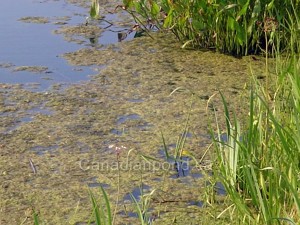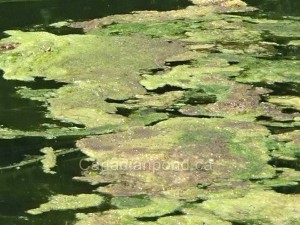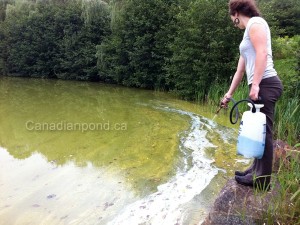Controlling algae in your pond
Algae are primitive plants that do not have true leaves, stems or roots and reproduce by spores, cell division and fragmentation. They develop from excess nutrients in the water and need sunlight to grow.
There are several types of algae that plague most of the ponds: the algae growing on the bottom or edges of the pond and algae that resembles green hair or plankton, or cyanobacteria, that makes your pond water green like pea soup!
Plankton is probably the most common type of algae found in ponds and lakes. Plankton basically needs two things to grow: light and nutrients. The light comes naturally from the sun and nutrients from the by-products of fish waste, dead leaves and decaying fish food (make sure not to over feed your fish), aquatic plants and weeds decaying and chemicals and fertilizers seeping into the pond. Most ponds have at least one, if not all of the nutrients listed above in their water.
The first line of defense to reduce algae in a pond is to protect your pond from surface nutrients. By allowing 1 to 3 meters of natural shoreline to grow around the pond, we trap surface nutrients from entering the water. This is helpful to reduce phosphorus that contributes to blue green algae blooms and other form of algae growth.
 Sunlight and warm weather promotes algae growth. Sunlight can be reduced by providing shade for your pond through aquatic plants such as lilies or from floating islands that can also block the sun.
Sunlight and warm weather promotes algae growth. Sunlight can be reduced by providing shade for your pond through aquatic plants such as lilies or from floating islands that can also block the sun.
Pond & Lake Dye added to your pond will blocks some of the sunlight entering the water that provide light to your plants and your algae. The pond water will turn a natural black or blue color all the while being safe for fish, swimming, etc…
Another option to reduce the nutrients responsible for algae growth is to clean your pond as much as possible. Remove the dead and decaying waste on the bottom and edges of the pond as much as possible. You can install a net in the fall to prevent the leaves from falling into the water or clean the debris falling into the lake every day or two with our aquatic tools products either manual or motorized.
Bacteria play an important role in the functioning of your pond. They eat the same nutrients in the water from the decomposition of leaves, leftover fish food, etc.., as algae. When you increase the amount of beneficial bacteria in your pond, you are helping to starve the algae and prevent them from growing thus creating better water quality. Bacteria have several functions: they contribute to the decomposition of sediment at the bottom of the pond, they eliminate odours, they reduce oxygen demand, they improve the clarity of the water, and they remove excess nutrients and control algae. They are also essential for transforming fish waste into harmless nitrates so that your fish do not die of ammonia poisoning. You can see that bacteria are essential for a healthy pond.
play an important role in the functioning of your pond. They eat the same nutrients in the water from the decomposition of leaves, leftover fish food, etc.., as algae. When you increase the amount of beneficial bacteria in your pond, you are helping to starve the algae and prevent them from growing thus creating better water quality. Bacteria have several functions: they contribute to the decomposition of sediment at the bottom of the pond, they eliminate odours, they reduce oxygen demand, they improve the clarity of the water, and they remove excess nutrients and control algae. They are also essential for transforming fish waste into harmless nitrates so that your fish do not die of ammonia poisoning. You can see that bacteria are essential for a healthy pond.
The effectiveness of the beneficial bacteria is enhanced by the use of an a lake bottom aeration system. Good aeration also contributes to the overall health of the pond and can help eliminate the “bad” bacteria that thrive in deep water where there is little or no oxygen and where the accumulation of sludge is high. After all, bacteria need a good source of oxygen like fish and aquatic plants in your pond do. Gradually, as your pond or water garden continues to age, the fish population, aquatic plants, weeds and mud rise rapidly and accumulate at the bottom of the pond. A good aeration system is critical to maintaining a healthy aquatic environment. We have a wide range of aeration systems for small ponds and water gardens to aeration systems for lakes and large ponds.

The remains of fish food can also be a common problem in ponds. Most of us have chosen to have a pond to enjoy nature in our backyards. We decided to have fish to feed them and admire them. Unfortunately, sometimes we over feed fish. We throw a handful of food in the water until the fish come to eat at the surface. If we do not see them right away, we take another handful and throw it in the water. To prevent this, feed your fish only a few granules at a time. Try to feed your fish on a regular schedule to establish a routine. The fish will get used to this routine and await your presence for the food they are about to receive. If they do not eat all the food in 3 minutes it means that they are not hungry and you should not give them more food, which will only increase your algae problem.
 An algaecide can destroy algae, but its effect could be short-lived. This is a temporary solution. Essentially what happens is that algae destroyed by the algaecide accumulates at the bottom of the pond and creates a lot of organic compost. This important contribution of nutrients in the pond is the reason why new algae appear again in a few weeks. People who continually use these products actually do aggravate the situation because the destroyed algae continuously provide more and more nutrients to algae that you are just trying to get rid! It’s a vicious cycle that must be stopped. For success with algaecides, add beneficial bacteria to the pond to minimize the nutrients available for the algae. This will eventually starve the algae and stop the cycle, making your water clearer, thus resulting in a healthier pond.
An algaecide can destroy algae, but its effect could be short-lived. This is a temporary solution. Essentially what happens is that algae destroyed by the algaecide accumulates at the bottom of the pond and creates a lot of organic compost. This important contribution of nutrients in the pond is the reason why new algae appear again in a few weeks. People who continually use these products actually do aggravate the situation because the destroyed algae continuously provide more and more nutrients to algae that you are just trying to get rid! It’s a vicious cycle that must be stopped. For success with algaecides, add beneficial bacteria to the pond to minimize the nutrients available for the algae. This will eventually starve the algae and stop the cycle, making your water clearer, thus resulting in a healthier pond.
Many ponds suffer from a spring algae bloom. It is only natural, but we know it is discouraging to most of you. After a long winter, we are so excited to see your fish and you cannot because the water is like pea soup! Part of this is due to the change in outside temperature. This happens because the bacteria have not yet begun to grow and the pond is full of nutrients due to dead leaves and decaying debris. Now, the algae have the upper hand and prosper. What you need to do is to add beneficial bacteria like Bacterius® EQUINOX in late fall. This cold water conditioner will degrade the leaves and sediment, so the condition of your pond in the spring already improved. You turn on your aerator and add Bacterius® EQUINOX when the water temperature reaches 5 °C. This gives you a head start on controlling the nutrient levels in your pond before the warm weather arrives creating havoc. You will see improvements within 2-3 weeks and will continue to see them as the season progresses. Continue adding beneficial bacteria throughout the season for proper maintenance, to reduce the algae and keep your pond clear.
Related Article: